Effectiveness of Nature-Based Solutions for Mitigating the Impact of Pluvial Flooding in Urban Areas at the Regional Scale
Abstract
1. Introduction
- (1)
- To develop a formal approach that is able to: (i) identify suitable locations of portfolios of NBSs at regional scales, enabling trade-offs between portfolio size and the corresponding reduction in urban flood impact to be determined; and (ii) model the flood reduction impact of portfolios of NBSs at regional scales at a resolution that enables the requisite analyses to be integrated with land use planning practices and to be conducted in a computationally efficient manner.
- (2)
- To illustrate the utility of the proposed approach by assessing the degree to which portfolios of nature-based solutions can mitigate urban flooding at the catchment scale for a case study in Adelaide, South Australia.
2. Methodology
2.1. Placement of Portfolios of NBSs at Regional Scales
2.2. Modeling of Impact of NBSs at Regional Scales
3. Case Study
3.1. Determination of Potential Locations for NBSs
3.2. Determination of Relevant Locations for NBSs
3.3. Determination of Placement of NBSs
3.4. Determination of Effectiveness of NBSs
4. Results and Discussion
4.1. Determination of Equivalent Infiltration Rate
4.2. Determination of Trade-Off between Number of NBSs and Effectiveness
5. Conclusions
Author Contributions
Funding
Data Availability Statement
Acknowledgments
Conflicts of Interest
Appendix A. Land Use Map Gawler River Region
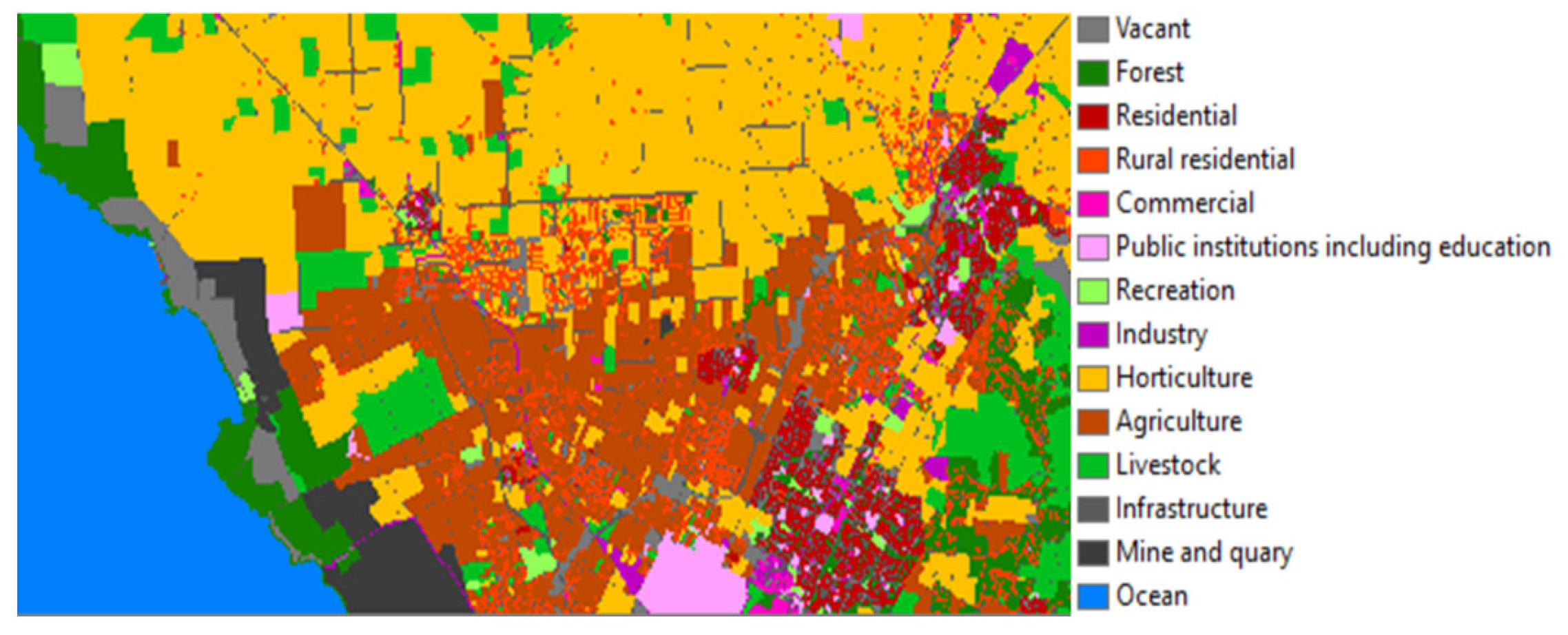
Appendix B. Flood Maps
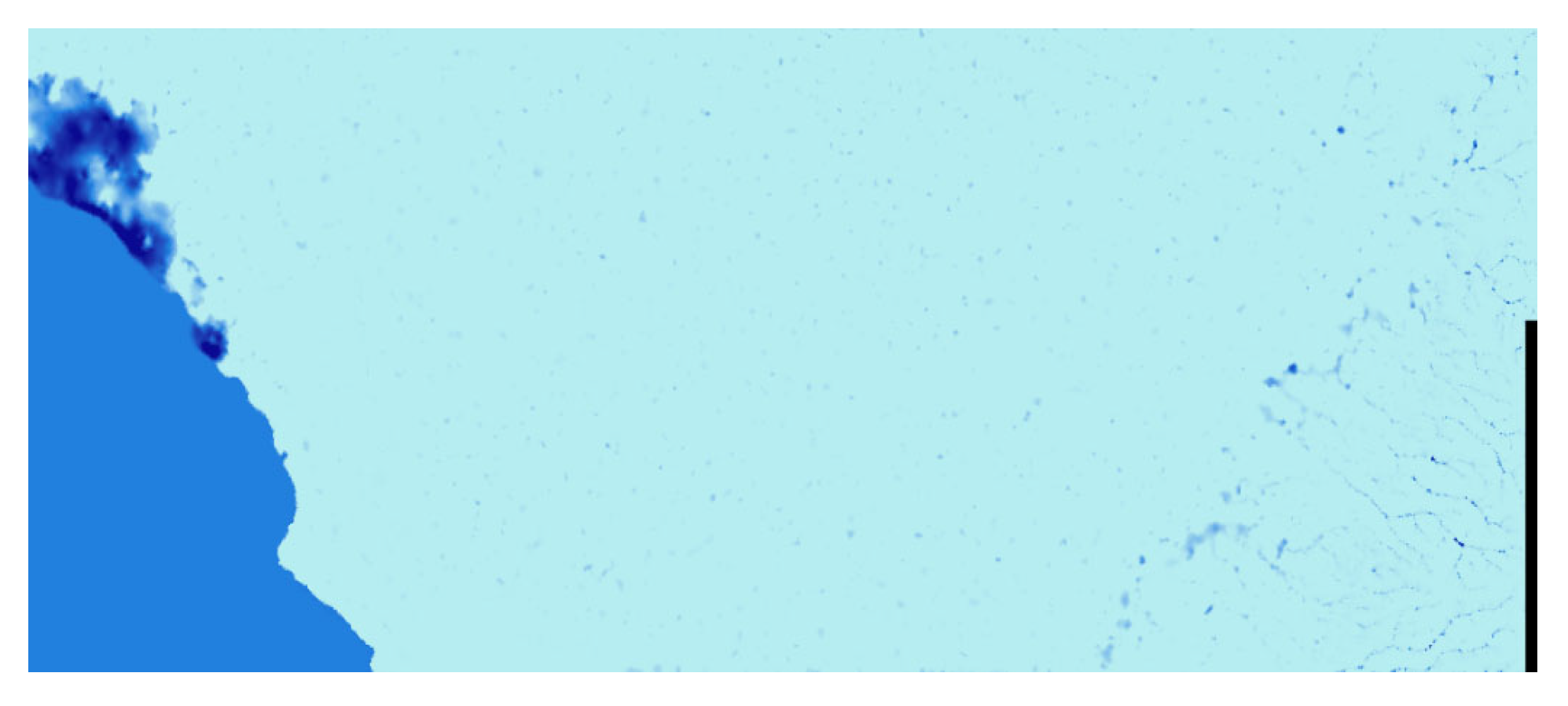
Appendix C. NBS Portfolio Placement throughout Gawler River Region
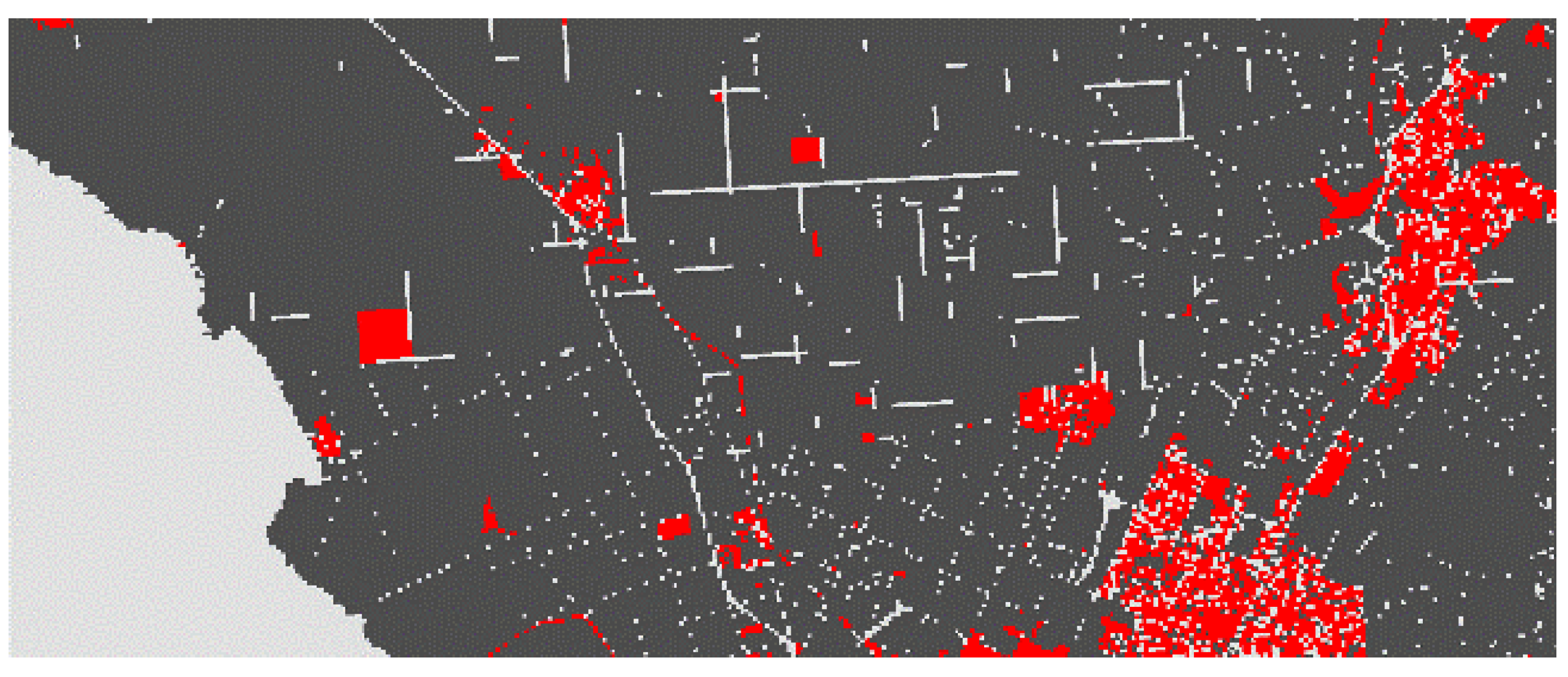
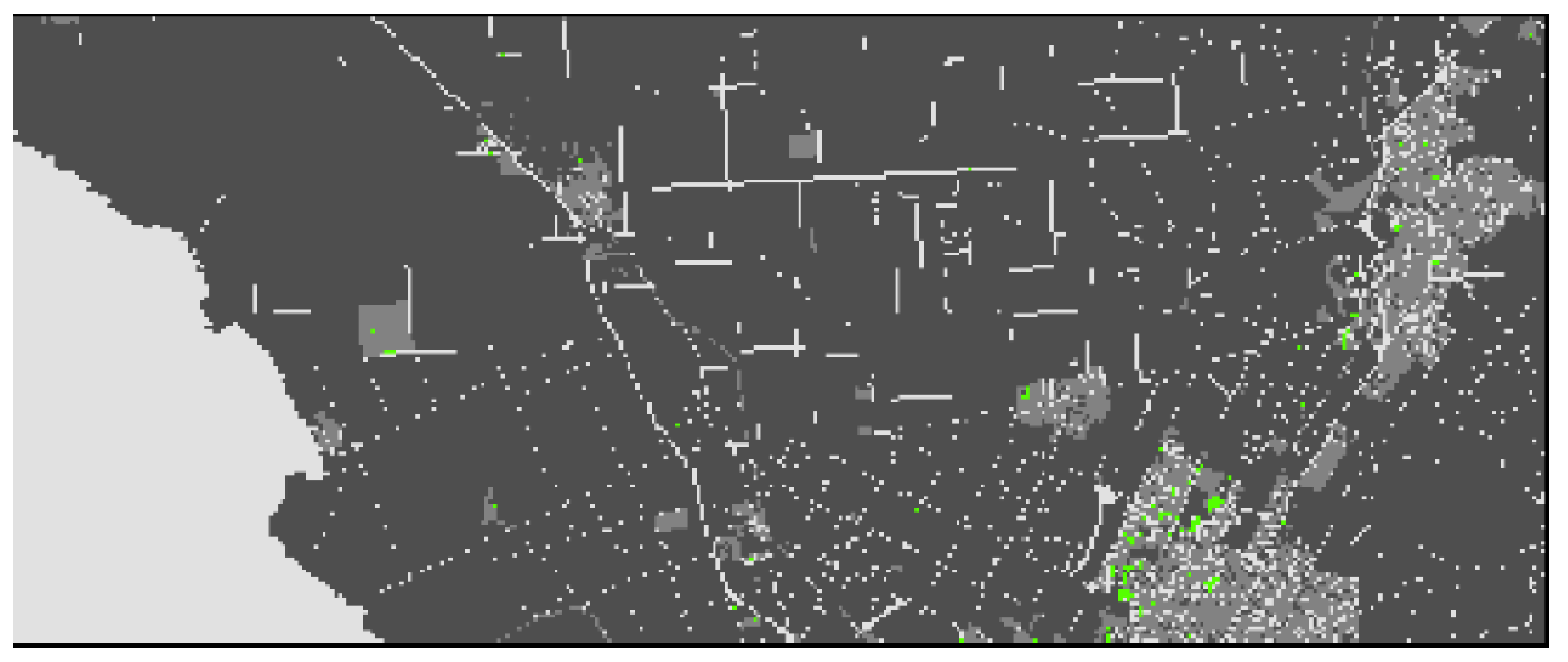


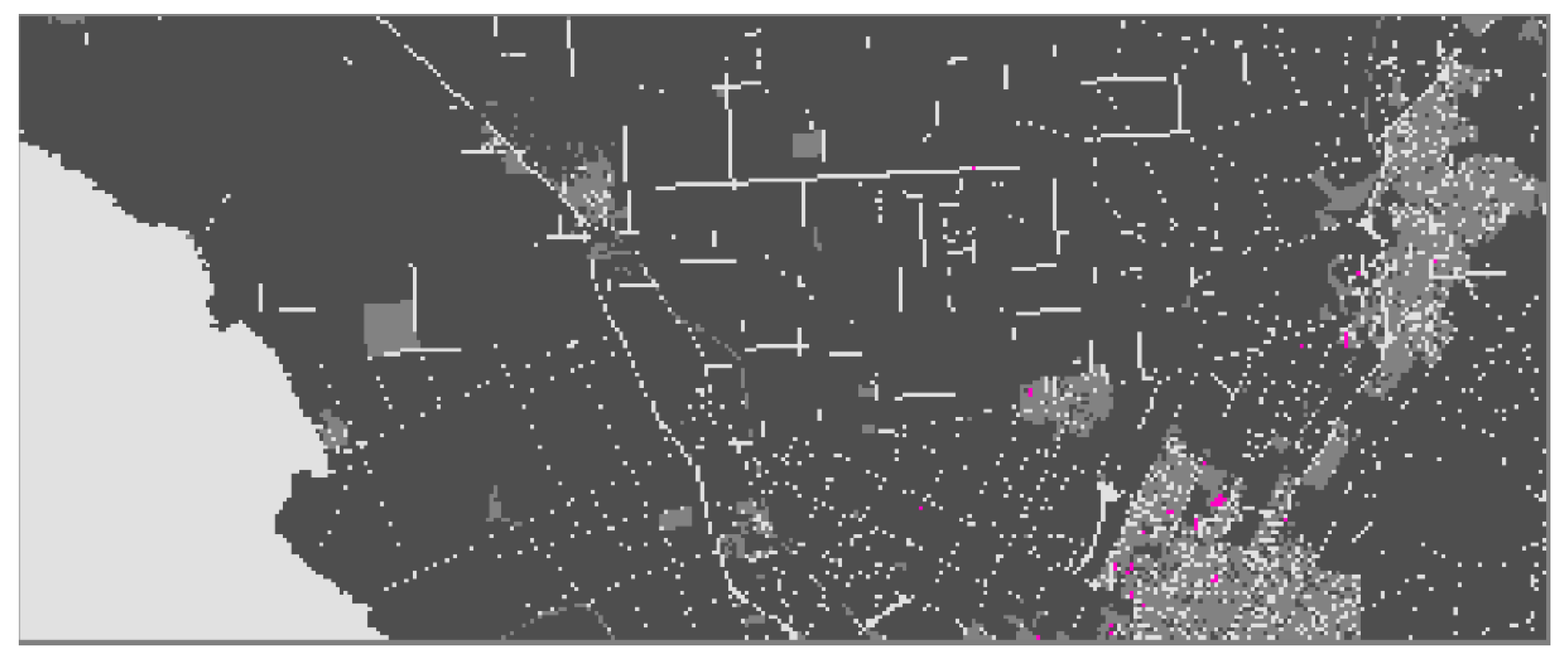
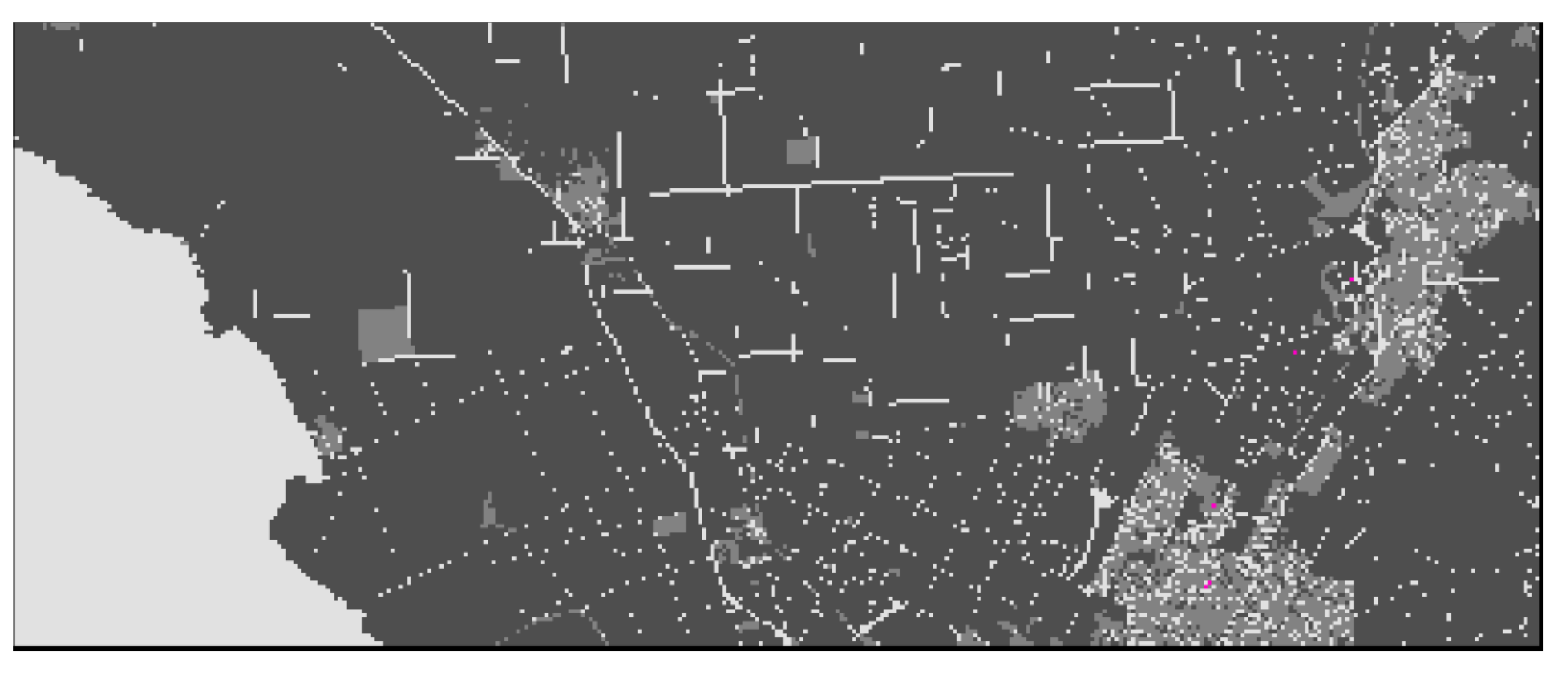
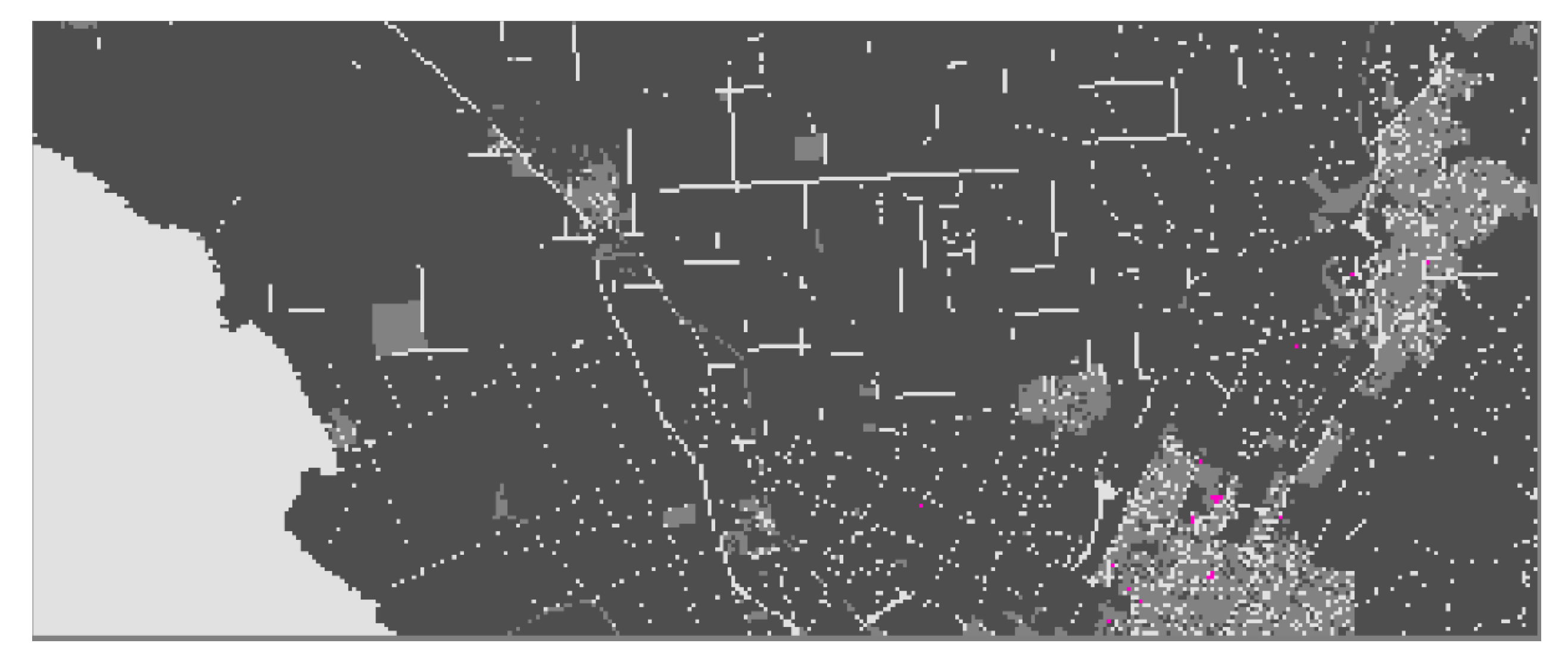
Appendix D. Performance of Uniform Infiltration Rate against the Two Different Schemes across the 100 m × 200 m Area

Appendix E. Flood Model Validation


Appendix F. Impact Assessment
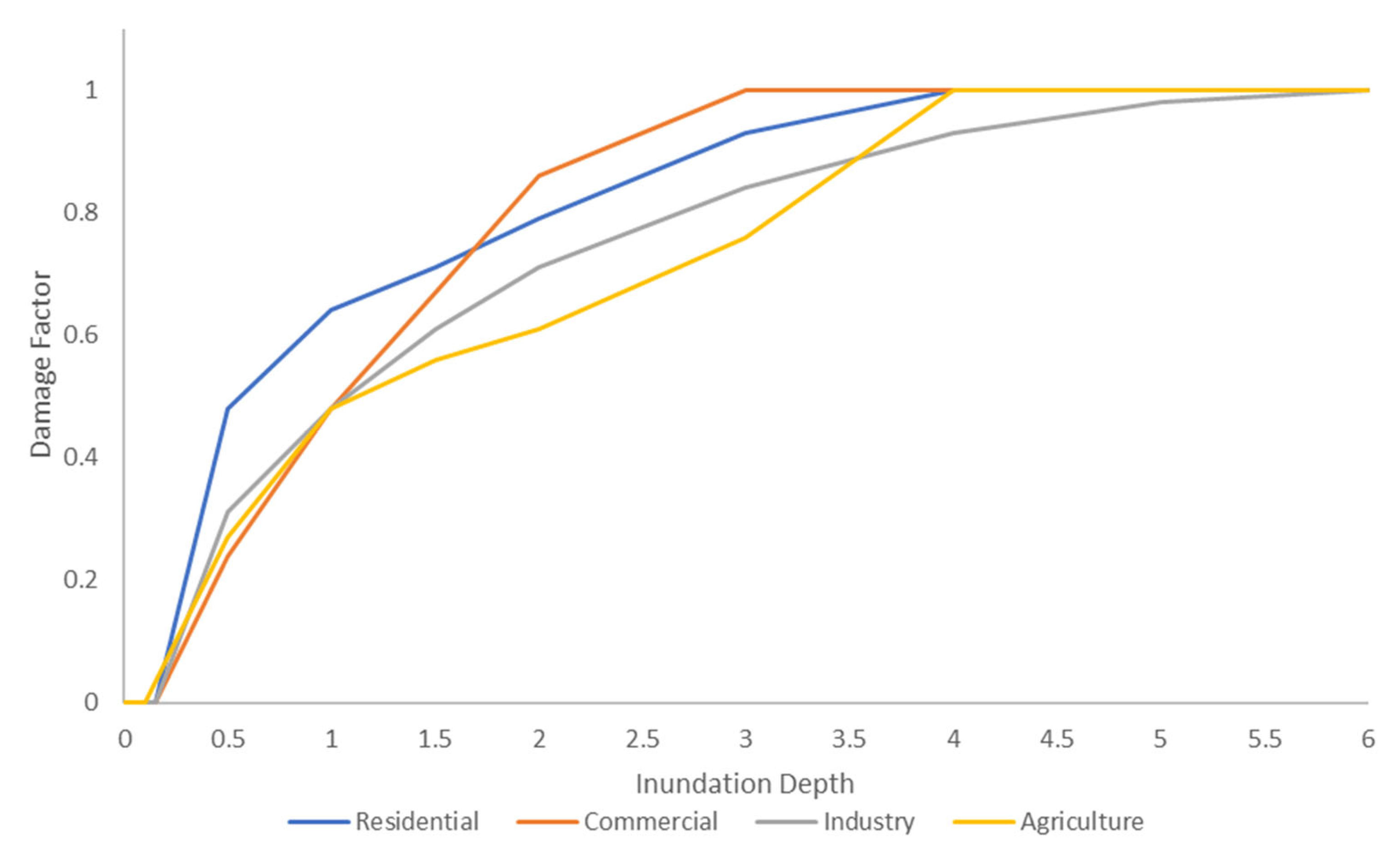
| Damage Factor | ||||
|---|---|---|---|---|
| Inundation Depth | Residential | Commercial | Industry | Agriculture |
| 0 | 0 | 0 | 0 | 0 |
| 0.15 | 0 | 0 | 0 | 0 |
| 0.5 | 0.48 | 0.24 | 0.31 | 0.27 |
| 1 | 0.64 | 0.48 | 0.48 | 0.48 |
| 1.5 | 0.71 | 0.67 | 0.61 | 0.56 |
| 2 | 0.79 | 0.86 | 0.71 | 0.61 |
| 3 | 0.93 | 1 | 0.84 | 0.76 |
| 4 | 1 | 1 | 0.93 | 1 |
| 5 | 1 | 1 | 0.98 | 1 |
| 6 | 1 | 1 | 1 | 1 |
| Residential | Rural Residential | Commercial | Industry | Agriculture | Horticulture | |
|---|---|---|---|---|---|---|
| Value | AUD 5,769,663 | AUD 338,349 | AUD 7,632,993 | AUD 732,208 | AUD 3053 | AUD 24,845 |
References
- Guha-Sapir, D. EM-DAT: The Emergency Events Database; Universite catholique de Louvain (UCL)—CRED: Brussels, Belgium, 2018. [Google Scholar]
- IFRC. Leaving No One Behind; International Federation of Red Cross, Red Crescent Societies: Geneva, Switzerland, 2018. [Google Scholar]
- Miller, J.D.; Kim, H.; Kjeldsen, T.R.; Packman, J.; Grebby, S.; Dearden, R. Assessing the impact of urbanization on storm runoff in a peri-urban catchment using historical change in impervious cover. J. Hydrol. 2014, 515, 59–70. [Google Scholar] [CrossRef]
- Jha, A.K.; Bloch, R.; Lamond, J. Cities and Flooding: A Guide to Integrated Urban Flood Risk Management for the 21st Century; World Bank Publications: Herndon, VA, USA, 2012. [Google Scholar]
- GFDRR. Understanding Risk in an Evolving World: A Policy Note; The World Bank: Herndon, VA, USA, 2014. [Google Scholar]
- Yan, B.; Fang, N.F.; Zhang, P.C.; Shi, Z.H. Impacts of land use change on watershed streamflow and sediment yield: An assessment using hydrologic modelling and partial least squares regression. J. Hydrol. 2013, 484, 26–37. [Google Scholar] [CrossRef]
- Athayde, D.; Shelley, P.; Driscol, E.; Gaboury, D.; Boyd, G. Results of the Nationwide Urban Runoff Program: Final Report; Environmental Protection Agency, Water Planning Division: Washington, DC, USA, 1983. [Google Scholar]
- Crichton, D. The risk triangle. Nat. Disaster Manag. 1999, 102, 103. [Google Scholar]
- Jongman, B.; Ward, P.J.; Aerts, J.C.J.H. Global exposure to river and coastal flooding: Long term trends and changes. Glob. Environ. Chang. 2012, 22, 823–835. [Google Scholar] [CrossRef]
- Bao, J.; Sherwood, S.C.; Alexander, L.V.; Evans, J.P. Future increases in extreme precipitation exceed observed scaling rates. Nat. Clim. Chang. 2017, 7, 128–132. [Google Scholar] [CrossRef]
- Guerreiro, S.B.; Fowler, H.J.; Barbero, R.; Westra, S.; Lenderink, G.; Blenkinsop, S.; Lewis, E.; Li, X.-F. Detection of continental-scale intensification of hourly rainfall extremes. Nat. Clim. Chang. 2018, 8, 803–807. [Google Scholar] [CrossRef]
- White, G.F. Human Adjustment to Floods: A Geographical Approach to the Flood Problem in the United States, in Department of Geography; University of Chicago: Chicago, IL, USA, 1942. [Google Scholar]
- Birkland, T.A.; Burby, R.J.; Conrad, D.; Cortner, H.; Michener, W.K. River ecology and flood hazard mitigation. Nat. Hazards Rev. 2003, 4, 46–54. [Google Scholar] [CrossRef]
- Thampapillai, D.J.; Musgrave, W.F. Flood Damage Mitigation: A Review of Structural and Nonstructural Measures and Alternative Decision Frameworks. Water Resour. Res. 1985, 21, 411–424. [Google Scholar] [CrossRef]
- Australian Institute for Disaster Resilience. Australian Disaster Resilience Handbook 7 Managing the Floodplain: A Guide to Best Practice in Flood Risk Management in Australia; Australian Institute for Disaster Resilience: East Melbourne, Australian, 2017. [Google Scholar]
- Dey, P.; Mishra, A. Separating the impacts of climate change and human activities on streamflow: A review of methodologies and critical assumptions. J. Hydrol. 2017, 548, 278–290. [Google Scholar] [CrossRef]
- Di Matteo, M.; Liang, R.; Maier, H.R.; Thyer, M.A.; Simpson, A.R.; Dandy, G.C.; Ernst, B. Controlling rainwater storage as a system: An opportunity to reduce urban flood peaks for rare, long duration storms. Environ. Model. Softw. 2019, 111, 34–41. [Google Scholar] [CrossRef]
- Liang, R.; Di Matteo, M.; Maier, H.R.; Thyer, M.A. Real-Time, Smart Rainwater Storage Systems: Potential Solution to Mitigate Urban Flooding. Water 2019, 11, 2428. [Google Scholar] [CrossRef]
- Hodgkins, G.A.; Whitfield, P.H.; Burn, D.H.; Hannaford, J.; Renard, B.; Stahl, K.; Fleig, A.K.; Madsen, H.; Mediero, L.; Korhonen, J.; et al. Climate-driven variability in the occurrence of major floods across North America and Europe. J. Hydrol. 2017, 552, 704–717. [Google Scholar] [CrossRef]
- van Herk, S.; Rijke, J.; Zevenbergen, C.; Ashley, R. Understanding the transition to integrated flood risk management in the Netherlands. Environ. Innov. Soc. Transit. 2015, 15, 84–100. [Google Scholar] [CrossRef]
- Zevenbergen, C.; van Tujin, J.; Rijke, J.; Bos, M.; Van Herk, S.; Douma, J.; van Riet Paap, L. Tailor Made Collaboration a Clever Combination of Process and Content; Rijkswaterstaat Room for the River: Utrecht, The Netherlands, 2013. [Google Scholar]
- Vergouwe, R. The National Flood Risk Analysis for The Netherlands; Rijkswaterstaat VNK Project Office: Den Haag, The Netherlands, 2016. [Google Scholar]
- Kabisch, N.; Korn, H.; Stadler, J.; Bonn, A. Nature-Based Solutions to Climate Change Adaptation in Urban Areas: Linkages between Science, Policy and Practice; Springer Nature: London, UK, 2017. [Google Scholar]
- Dawson, R.J.; Ball, T.; Werritty, J.; Werritty, A.; Hall, J.W.; Roche, N. Assessing the effectiveness of non-structural flood management measures in the Thames Estuary under conditions of socio-economic and environmental change. Glob. Environ. Chang. 2011, 21, 628–646. [Google Scholar] [CrossRef]
- Liang, R.; Maier, H.R.; Thyer, M.A.; Dandy, G.C.; Tan, Y.; Chhay, M.; Sau, T.; Lam, V. Calibration-free approach to reactive real-time control of stormwater storages. J. Hydrol. 2022, 614, 128559. [Google Scholar] [CrossRef]
- Castellar, J.A.C.; Popartan, L.A.; Pueyo-Ros, J.; Atanasova, N.; Langergraber, G.; Saumel, I.; Corominas, L.; Comas, J.; Acuna, V. Nature-based solutions in the urban context: Terminology, classification and scoring for urban challenges and ecosystem services. Sci. Total Environ. 2021, 779, 146237. [Google Scholar] [CrossRef]
- Zölch, T.; Henze, L.; Keilholz, P.; Pauleit, S. Regulating urban surface runoff through nature-based solutions—An assessment at the micro-scale. Environ. Res. 2017, 157, 135–144. [Google Scholar] [CrossRef]
- Kumar, P.; Debele, S.E.; Sahani, J.; Rawat, N.; Marti-Cardona, B.; Alfieri, S.M.; Basu, B.; Basu, A.S.; Bowyer, P.; Charizopoulos, N.; et al. Nature-based solutions efficiency evaluation against natural hazards: Modelling methods, advantages and limitations. Sci. Total Environ. 2021, 784, 147058. [Google Scholar] [CrossRef]
- Cameron, R.W.F.; Blanuša, T.; Taylor, J.E.; Salisbury, A.; Halstead, A.J.; Henricot, B.; Thompson, K. The domestic garden—Its contribution to urban green infrastructure. Urban For. Urban Green. 2012, 11, 129–137. [Google Scholar] [CrossRef]
- Whitford, V.; Ennos, A.R.; Handley, J.F. “City form and natural process”—Indicators for the ecological performance of urban areas and their application to Merseyside, UK. Landsc. Urban Plan. 2001, 57, 91–103. [Google Scholar] [CrossRef]
- Liang, R.; Thyer, M.A.; Maier, H.R.; Dandy, G.C.; Di Matteo, M. Optimising the design and real-time operation of systems of distributed stormwater storages to reduce urban flooding at the catchment scale. J. Hydrol. 2021, 602, 126787. [Google Scholar] [CrossRef]
- Australian Institute for Disaster Resilience. Flood Information to Support Land-Use Planning; Australian Institute for Disaster Resilience: East Melbourne, Australian, 2017. [Google Scholar]
- Chen, V.; Bonilla Brenes, J.R.; Chapa, F.; Hack, J. Development and modelling of realistic retrofitted Nature-based Solution scenarios to reduce flood occurrence at the catchment scale. Ambio 2021, 50, 1462–1476. [Google Scholar] [CrossRef] [PubMed]
- Huang, Y.; Tian, Z.; Ke, Q.; Liu, J.; Irannezhad, M.; Fan, D.; Hou, M.; Sun, L. Nature-based solutions for urban pluvial flood risk management. Wiley Interdiscip. Rev. Water 2020, 7, e1421. [Google Scholar] [CrossRef]
- Vojinovic, Z.; Alves, A.; Gomez, J.P.; Weesakul, S.; Keerakamolchai, W.; Meesuk, V.; Sanchez, A. Effectiveness of small- and large-scale Nature-Based Solutions for flood mitigation: The case of Ayutthaya, Thailand. Sci. Total Environ. 2021, 789, 147725. [Google Scholar] [CrossRef] [PubMed]
- Kim, H.W.; Park, Y. Urban green infrastructure and local flooding: The impact of landscape patterns on peak runoff in four Texas MSAs. Appl. Geogr. 2016, 77, 72–81. [Google Scholar] [CrossRef]
- Zellner, M.; Massey, D.; Minor, E.; Gonzalez-Meler, M. Exploring the effects of green infrastructure placement on neighborhood-level flooding via spatially explicit simulations. Comput. Environ. Urban Syst. 2016, 59, 116–128. [Google Scholar] [CrossRef]
- Pappalardo, V.; La Rosa, D.; Campisano, A.; La Greca, P. The potential of green infrastructure application in urban runoff control for land use planning: A preliminary evaluation from a southern Italy case study. Ecosyst. Serv. 2017, 26, 345–354. [Google Scholar] [CrossRef]
- Fastenrath, S.; Bush, J.; Coenen, L. Scaling-up nature-based solutions. Lessons from the Living Melbourne strategy. Geoforum 2020, 116, 63–72. [Google Scholar] [CrossRef]
- Hankin, B.; Page, T.; McShane, G.; Chappell, N.; Spray, C.; Black, A.; Comins, L. How can we plan resilient systems of nature-based mitigation measures in larger catchments for flood risk reduction now and in the future? Water Secur. 2021, 13, 10091. [Google Scholar] [CrossRef]
- Maier, H.R.; Razavi, S.; Kapelan, Z.; Matott, L.S.; Kasprzyk, J.; Tolson, B.A. Introductory overview: Optimization using evolutionary algorithms and other metaheuristics. Environ. Model. Softw. 2019, 114, 195–213. [Google Scholar] [CrossRef]
- Di Matteo, M.; Dandy, G.C.; Maier, H.R. A multi-stakeholder portfolio optimization framework applied to stormwater best management practice (BMP) selection. Environ. Model. Softw. 2017, 97, 16–31. [Google Scholar] [CrossRef]
- Di Matteo, M.; Maier, H.R.; Dandy, G.C. Many-objective portfolio optimization approach for stormwater management project selection encouraging decision maker buy-in. Environ. Model. Softw. 2019, 111, 340–355. [Google Scholar] [CrossRef]
- Wu, W.; Maier, H.R.; Dandy, G.C.; Leonard, R.; Bellette, K.; Cuddy, S.; Maheepala, S. Including stakeholder input in formulating and solving real-world optimisation problems: Generic framework and case study. Environ. Model. Softw. 2016, 79, 197–213. [Google Scholar] [CrossRef]
- Newland, C.P.; van Delden, H.; Zecchin, A.C.; Newman, J.P.; Maier, H.R. A hybrid (semi) automatic calibration method for Cellular Automata land-use models: Combining evolutionary algorithms with process understanding. Environ. Model. Softw. 2020, 134, 104830. [Google Scholar] [CrossRef]
- Newland, C.P.; Maier, H.R.; Zecchin, A.C.; Newman, J.P.; van Delden, H. Multi-objective optimisation framework for calibration of Cellular Automata land-use models. Environ. Model. Softw. 2018, 100, 175–200. [Google Scholar] [CrossRef]
- Bennett, N.D.; Croke, B.F.W.; Guariso, G.; Guillaume, J.H.A.; Hamilton, S.H.; Jakeman, A.J.; Marsili-Libelli, S.; Newham, L.T.H.; Norton, J.P.; Perrin, C.; et al. Characterising performance of environmental models. Environ. Model. Softw. 2013, 40, 1–20. [Google Scholar] [CrossRef]
- Bi, W.; Maier, H.R.; Dandy, G.C. Impact of Starting Position and Searching Mechanism on the Evolutionary Algorithm Convergence Rate. J. Water Resour. Plan. Manag. 2016, 142, 04016026. [Google Scholar] [CrossRef]
- Tonkin Consulting. Northern Floodway, Project Prospectus; Tonkin Consulting: Adelaide, Australia, 2018. [Google Scholar]
- Fisher, G.; Taylor, B.; Skilton, B.; Hewett, F.; Dermek, R.; Arrowsmith, C. Gawler River 2016 Flood Review Project Report; Australian Water Environments: Adelaide, Australia, 2017. [Google Scholar]
- Water Sensitive SA. Technical Manual for Water Sensitive Urban Design in Greater Adelaide; Water Sensitive SA: Adelaide, Australia, 2010. [Google Scholar]
- DHI. Mike Flood, 1D-2D Modelling User Manual; Danish Hydraulic Institute: Hørsholm, Denmark, 2017. [Google Scholar]
- Meshram, S.G.; Ilderomi, A.R.; Sepehri, M.; Jahanbakhshi, F.; Kiani-Harchegani, M.; Ghahramani, A.; Rodrigo-Comino, J. Impact of roof rain water harvesting of runoff capture and household consumption. Environ. Sci. Pollut. Res. Int. 2021, 28, 49529–49540. [Google Scholar] [CrossRef]
- Van Delden, H.; Vanhout, R.; Riddell, G.; Koks, E.; Radford, D.; Dandy, G.C.; Hamers, E.; Maier, H.R.; Zecchin, A.C. Integrated Assessment of Flood Mitigation Options; GRUMP—Gawler River UNHaRMED Mitigation Project: Adelaide, Australia, 2022. [Google Scholar]
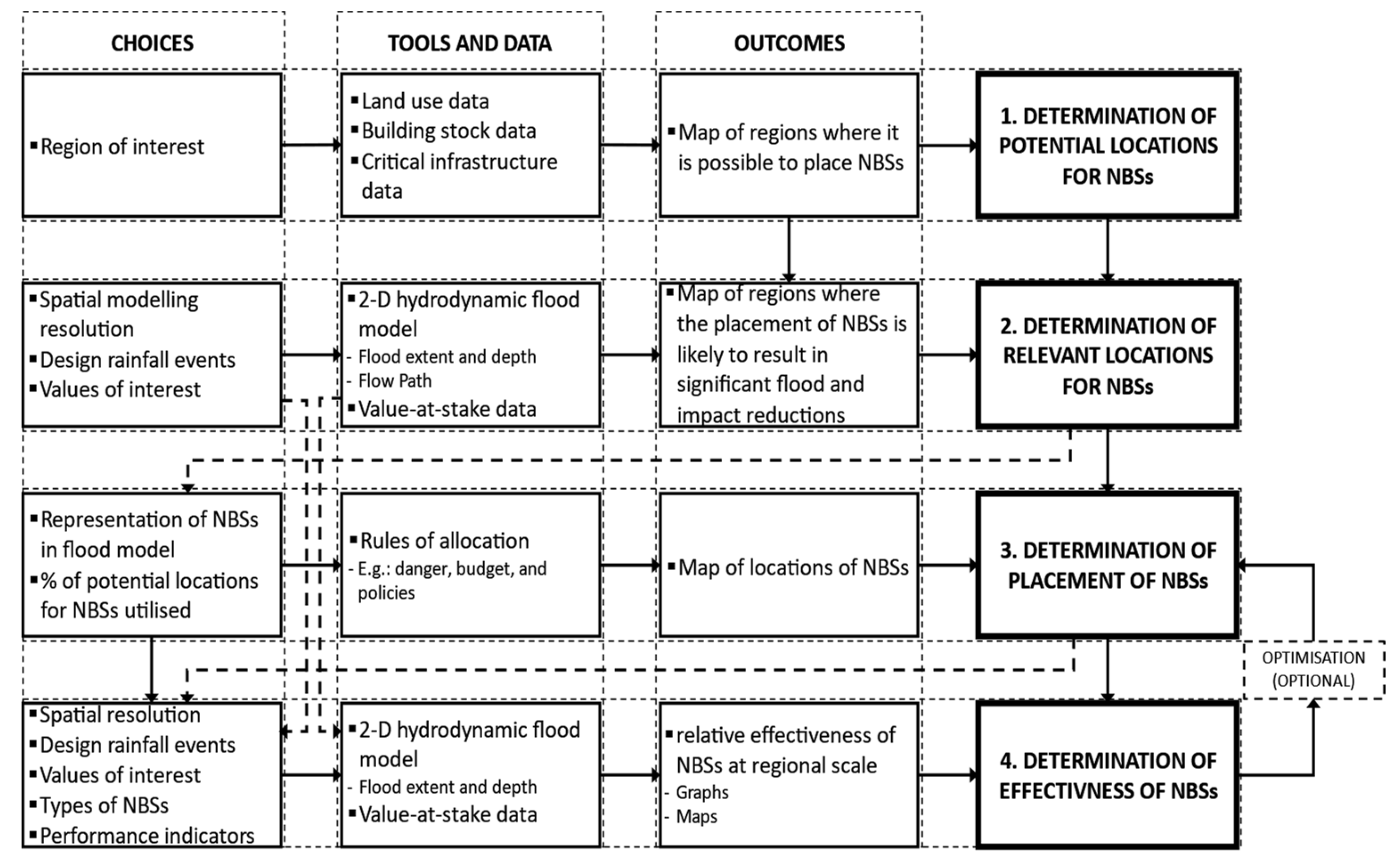

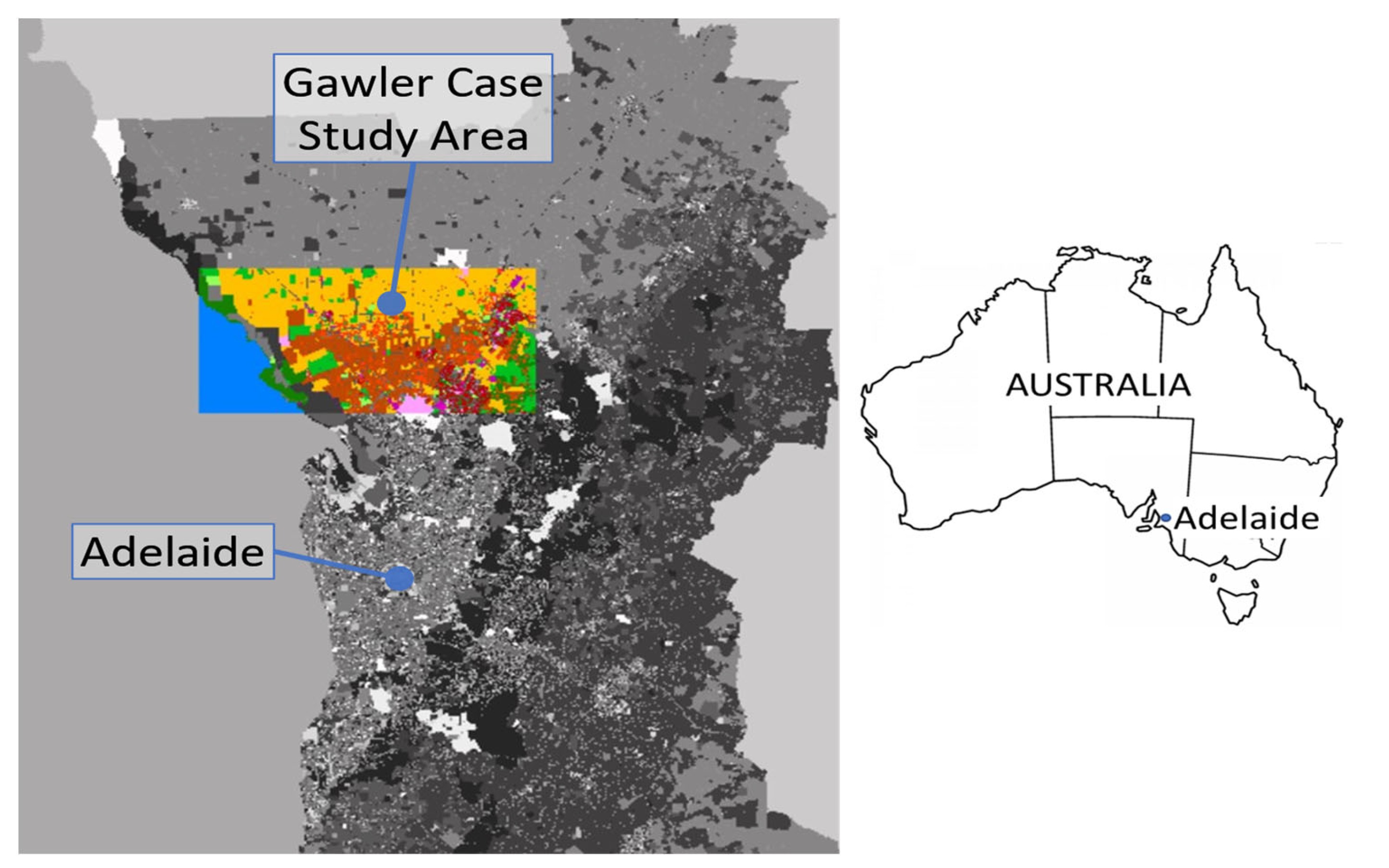

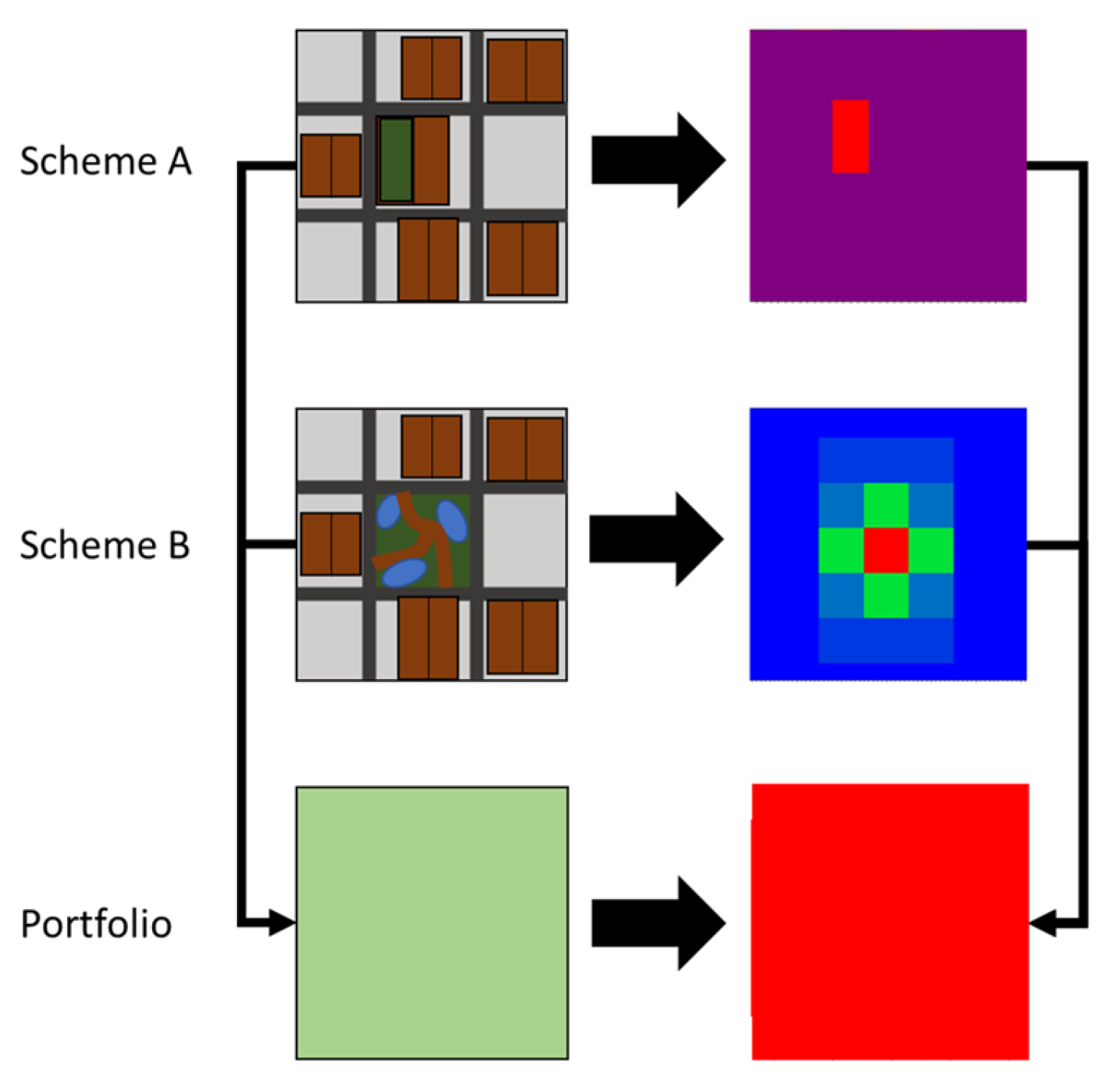




| Chosen Thresholds [cm] | 90 | 70 | 50 | 30 | Relevant | Restricted Potential | Potential |
| Area [km2] | 0.03 | 0.18 | 0.40 | 0.70 | 1.17 | 19.38 | 38.69 |
| Utilization of catchment | 0.005% | 0.03% | 0.07% | 0.12% | 0.20% | 3.34% | 6.66% |
| Utilization of potential | 0.08% | 0.48% | 1.03% | 1.81% | 3.02% | 50.1% | 100% |
| Utilization of relevant | 2.48% | 15.8% | 34.1% | 59.9% | 100% | - | - |
Disclaimer/Publisher’s Note: The statements, opinions and data contained in all publications are solely those of the individual author(s) and contributor(s) and not of MDPI and/or the editor(s). MDPI and/or the editor(s) disclaim responsibility for any injury to people or property resulting from any ideas, methods, instructions or products referred to in the content. |
© 2023 by the authors. Licensee MDPI, Basel, Switzerland. This article is an open access article distributed under the terms and conditions of the Creative Commons Attribution (CC BY) license (https://creativecommons.org/licenses/by/4.0/).
Share and Cite
Hamers, E.M.; Maier, H.R.; Zecchin, A.C.; van Delden, H. Effectiveness of Nature-Based Solutions for Mitigating the Impact of Pluvial Flooding in Urban Areas at the Regional Scale. Water 2023, 15, 642. https://doi.org/10.3390/w15040642
Hamers EM, Maier HR, Zecchin AC, van Delden H. Effectiveness of Nature-Based Solutions for Mitigating the Impact of Pluvial Flooding in Urban Areas at the Regional Scale. Water. 2023; 15(4):642. https://doi.org/10.3390/w15040642
Chicago/Turabian StyleHamers, Eike M., Holger R. Maier, Aaron C. Zecchin, and Hedwig van Delden. 2023. "Effectiveness of Nature-Based Solutions for Mitigating the Impact of Pluvial Flooding in Urban Areas at the Regional Scale" Water 15, no. 4: 642. https://doi.org/10.3390/w15040642
APA StyleHamers, E. M., Maier, H. R., Zecchin, A. C., & van Delden, H. (2023). Effectiveness of Nature-Based Solutions for Mitigating the Impact of Pluvial Flooding in Urban Areas at the Regional Scale. Water, 15(4), 642. https://doi.org/10.3390/w15040642







